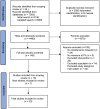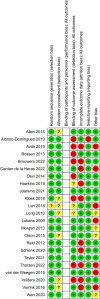The effectiveness of digital tools to maintain physical activity among people with a long-term condition(s): A systematic review and meta-analysis
- PMID: 39711739
- PMCID: PMC11660288
- DOI: 10.1177/20552076241299864
The effectiveness of digital tools to maintain physical activity among people with a long-term condition(s): A systematic review and meta-analysis
Abstract
Objective: Given the well-accepted health benefits, it is important to identify scalable ways to support people with long-term conditions (LTCs) to remain physically active. This systematic review aimed to evaluate the effect of digital tools on the maintenance of physical activity (PA) amongst this population.
Methods: Electronic databases were searched for randomised controlled trials investigating the effect of digital tools on PA maintenance at least three months post-intervention compared with a non-digital control in participants with long-term conditions. Meta-analyses were conducted at post-intervention and longest maintenance timepoint; subgroup analyses explored the effect of the type of control. Prospero registration: CRD42022299967.
Results: Twenty-three studies (n = 5350 participants) were included, with the majority at unclear/high risk of bias. Web-based tools were commonly used (18 studies), 10 monitored PA with a sensor, and digital interventions were often combined with supervised exercise/walks. The overall meta-analysis showed no significant difference in PA between digital interventions compared with any type of control (device-based outcomes: SMD = -0.07, 95% CI [-0.35, 0.21]; self-reported outcomes: SMD = 0.11, 95% CI [-0.01, 0.24]). However, this was moderated by type of control group with subgroup analyses suggesting that the effect of digital interventions on PA surpassed that of an inactive/minimal control at post-intervention (SMD = 0.29) and maintenance timepoints (SMD = 0.24).
Conclusions: This review provides preliminary evidence that interventions incorporating digital tools may be more effective than minimal controls at supporting people with LTCs to maintain PA. Given the quality of the evidence, confidence in these findings is very low and may change with future research.
Keywords: Physical activity maintenance; device based and self-report physical activity outcomes; digital health; multiple long-term conditions.
© The Author(s) 2024.
Conflict of interest statement
The authors declared no potential conflicts of interest with respect to the research, authorship, and/or publication of this article.
Figures












References
-
- World Health Organization. Physical activity. World Health Organization; Available at: https://www.who.int/dietphysicalactivity/pa/en/ (2019, accessed 14 November 2019).
-
- Saunders DH, Sanderson M, Hayes S, et al. Physical fitness training for stroke patients. Cochrane Database Syst Rev 2020; 3. https://doi.org/10.1002/14651858.CD003316.pub7 - PMC - PubMed
Publication types
LinkOut - more resources
Full Text Sources

